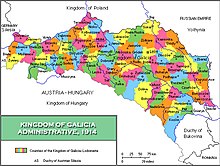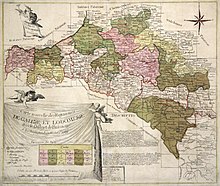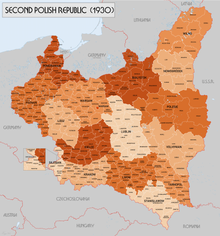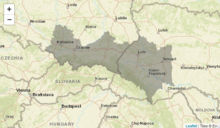|
Subdivisions of the Kingdom of Galicia and Lodomeria
 The Kingdom of Galicia and Lodomeria, a crown land of Austria-Hungary, was subdivided into political districts (German: Bezirkshauptmannschaften) for administrative purposes, which were referred to in Polish as powiaty (administrative counties). When they were introduced in 1867 there were 74 of these administrative counties;[1] in 1900 there were 78 counties. The administrative counties were responsible for storing vital records. These counties were introduced following the 1867 December Constitution. Prior to 1867, while a crown land of the Austrian Empire and before that as part of the Habsburg monarchy, the kingdom had instead been divided into Kreise since the late 18th century, which from 1854 were subdivided into Bezirke (referred to as Amtsbezirke ('office districts'), to distinguish them from other types of Bezirk). The Kingdom of Galicia and Lodomeria was the largest and most populous crown land of Cisleithania (i.e. the non-Hungarian parts of the Habsburg realms) between 1772 and 1918. More widely, the central European region of Galicia is today split between the modern states of Poland and Ukraine. Despite having passed through several intermediate states during the great wars of the 20th century, the regions have mainly preserved their territorial integrity and continue to demarcate the jurisdiction of local government authorities in their successor states. Kreise (until 1865) The Kreise (lit. 'circles'; sg. Kreis; Polish: cyrkuły, sg. cyrkuł; Ukrainian: округи okruhy, sg. округ okruh) of Galicia and Lodomeria go back in some form to the aftermath of the First Partition of Poland in 1772 which led to the Kingdom's creation, but did not take something resembling their final form until 1782. They were (generally) named after their capital/seat; usually this would take the form [genitival adjectival form of the name] Kreis (usually simply [Name]er Kreis e.g. Lemberger Kreis from Lemberg, the German name for Lviv), but Kreis [standard form of the name] (e.g. Kreis Lemberg) was also used, especially later, and the two forms were interchangeable. At first, Galicia and Lodomeria was divided into 6 large Kreise, which were subdivided into 59 Kreisdistrikte ('circle districts') in 1773. In 1777 the number of Kreisdistrikte was reduced to 19.  In 1782 the two-level system was abolished and Galicia and Lodomeria was divided into 18 Kreise of the type used in the other non-Hungarian Habsburg realms (what would later be called Cisleithania). Over the next decade these would mostly take the forms which would persist until the mid-19th century. As the border of Galicia and Lodomeria itself, the Vistula formed the northern borders of the Myslenicer, Bochnier, Tarnower and (partially) Rzeszower Kreise. The Bukowiner Kreis (an exception where the name derives from the region, although it was also known as Czernowitzer Kreis) was added to Galicia and Lodomeria in 1786, having previously been a separate military district. By the 1790s the Kreise were:[2]
The lands gained by the Habsburgs in the 1795 Third Partition of Poland became West (or New) Galicia, a separate part of the kingdom. It too was divided into Kreise; the western Myślenicer, Sandecer and Bochnier Kreise, which lay in the vicinity of the capital Krakau, were also attached to West Galicia. The area around Krakau on the right (southern) bank of the Vistula was transferred to the Krakauer Kreis. West Galicia was incorporated into Galicia-proper in 1803 as a semi-autonomous region. West Galicia was largely bounded by the Vistula, Bug and Pilica rivers. The Vistula also formed the eastern border of the Radomer Kreis, the western border of the Josefower and Wiazownaer Kreise, the eastern and southern border of the Opatower Kreis, the southern border of the Stopnicer Kreis and part of those of the Slomniker and Krakauer Kreise. The West Galician Kreise c. 1803:
By the early 19th century the Dukler Kreis had become the Jasłoer Kreis when its capital moved there. In 1804 the Habsburg monarchy, which until then had been de jure a collection of nominally separate states in a personal union under the Habsburg(-Lorraine)s, was formally united into the Austrian Empire, making Galicia and Lodomeria an Austrian crown land. In 1809 the Treaty of Schönbrunn ceded the third-partition-territory plus the Zamośćer Kreis and an area around Krakau on the right bank of the Vistula to the Duchy of Warsaw,[3] a Napoleonic client. It also ceded the Tarnopoler Kreis and most of the Zalestschyker Kreis to the Russian Empire,[4] where they became the Tarnopolsky Krai. Most of the rump of Zalestschyker Kreis was merged with a part of the Stanislauer Kreis to become the Kolomeaer Kreis with the rest going to the Stanislauer Kreis itself. The Tarnopolsky Krai was returned to Austria in 1815 (Congress of Vienna); the former Zalestschyker Kreis became the Czortkower Kreis. The area adjacent to Krakau on the right bank of the Vistula, which had been part of the Duchy of Warsaw, went to the Myslenicer and Bochnier Kreise, re-establishing the Vistula as the border. (The other territories which had been ceded to the Duchy of Warsaw on the other hand went to the Russian-controlled Congress Poland, other than the city of Kraków and its environs, which became the Free City of Cracow.) In 1819 the Myslenicer Kreis became the Wadowicer Kreis. The Free City of Cracow was annexed by Austria in 1846, nominally becoming the Grand Duchy of Kraków but administratively added to Galicia as the Krakauer Kreis. The extent of this Kreis, which matched that of the former free city, was similar but not identical to the earlier Krakauer Kreis of West Galicia. The Bukowiner Kreis was detached as the Duchy of Bukovina in 1849.[5] In 1850, following the Revolutions of 1848 the Kreise were abolished and replaced with a system of political districts (see § Regierungsbezirke and political districts (1850–53)) but these changes were reversed in Bach's reforms from 1853.[6] The changes to Galicia and Lodomeria were specifically laid out in 1854: they divided the crown land into two Verwaltungsgebiete (administrative regions/territories) based in Lemberg (Lviv/Lwów) and Krakau (Krawów), which each oversaw some of the land's Kreise; the two cities themselves were directly subordinate to the crown land. The Kreise were also subdivided into Bezirke ('districts'; also referred to as Amtsbezirke ('office districts')).[7] In 1860 Verwaltungsgebiet Krakau and Bukovina were dissolved and re-subordinated to Lemberg; the Jasłoer Kreis was partitioned between the Sandecer, Tarnower, Rzeszower and Sanoker Kreise; the Wadowicer and Bochnier Kreise were merged into Kreis Krakau.[8] Bukovina was detached again in the 1861 February Patent.[9] Below is a list of the divisions (Verwaltungsgebiete, Kreise and Bezirke) as of 1854,[7] with changes after that noted. (Divisions are listed with the names used in the legislation, i.e. mostly in contemporary German and/or Polish. Capitals are in bold.):
The Kreise in Galicia and Lodomeria were abolished in 1865 (enacted 23 September, effective 31 October), with the Bezirksämter subordinated directly to Lemberg.[11] Regierungsbezirke and political districts (1850–53)In 1850, in the aftermath of the revolutions of 1848, Galicia and Lodomeria was divided into three Regierungsbezirke ('government districts'), named after their capitals: Lemberg (Lviv/Lwów), Krakau (Kraków) and Stanislau (Stanislaviv/Stanisławów; today called Ivano-Frankivsk). The Kreise were abolished and replaced with political districts (Bezirkshauptmannschaften).[12] While political districts where also introduced in many other crown lands, they generally either retained their Kreise (often with a reduced number) or were not divided other than into political districts; the Regierungsbezirke were specific to Galicia and Lodomeria. This first attempt to introduce political districts to the Empire ended in 1853 with Bach's reforms.
Political districts (from 1867) In 1867 political districts (German: Bezirke, Polish: powiaty; also called counties (in the administrative sense) when translated from the Polish – see Powiat § Names and English equivalents) were reintroduced to Galicia and Lodomeria. They originally numbered 74:[1]
Some other districts were created later:
In 1902 the Galician-Hungarian border was adjusted slightly, now running along the mountain ridge through the peak of Rysy; prior to this it had run through the Morskie Oko lake about a kilometre to the west. This therefore slightly expanded Neumarkt/Nowy Targ district. Later HistoryInterwar period   During the Interwar period what had been Galicia and Lodomeria became part of the Second Polish Republic. Its territory became the Kraków, Lwów, Tarnopol and Stanisławów Voivodeships. For the most part the former political districts were transitioned directly into Polish powiats (counties or districts). Kraków Voivodeship (specifically Nowy Targ powiat, which corresponds to the modern Nowy Targ and Tatra powiats) also contained a small amount of territory annexed from Hungary (Jabłonka and Nowa Biała), which would become a border conflict with Czechoslovakia. In 1938 some additional territories along what was by this time the Polish-Czechoslovak border were ceded to Kraków Voivodeship: Javorina and Lesnica. World War II In 1939 at the beginning of World War II Poland was jointly occupied and annexed by Nazi Germany and the Soviet Union in accordance with the Molotov–Ribbentrop Pact. Most of the western parts of the former Galicia and Lodomeria became part of the Nazi General Government, largely forming the Kraków District (Distrikt Krakau), although some additional areas north of Kraków (most of which had incidentally been part of West Galicia) were also included; the northeastern border lay along the San, placing a small part of it in the Lublin District (Distrikt Lublin). The parts furthest to the west became part of Germany-proper within the East Upper Silesia area of Upper Silesia Province. The border between the General Government and what was by this time the Slovak State was restored to that of the pre-1918 Galicia-Hungary border. The Soviet-annexed formerly Galician territories became the Drohobych, Lviv, Stanislav (now Ivano-Frankivsk) and Tarnopil Oblasts of the Ukrainian SSR, which broadly correspond with the modern Lviv, Ivano-Frankivsk and Ternopil Oblasts (see below). In July 1941 as part of the Nazi invasion of the Soviet Union the rest of the former Galicia and Lodomeria was annexed by Germany. Some western parts of this territory became part of the Kraków District while the rest formed the District of Galicia (Distrikt Galizien), which also gained a small amount of formerly Galician territory from the Lublin District which had been on the German-side of the 1939 border. The external borders of the District of Galicia (other than with the Kraków District) matched those of the former kingdom. Modern divisions Administrative divisions in present-day PolandIn Poland today, there are parts of three voivodeships (provinces) that collectively formed the western part of the Kingdom of Galicia and Lodomeria.[13] Only Podkarpackie Voivodeship ("Subcarpathia") was entirely contained in the Kingdom. The majority of the territory of the Lesser Poland Voivodeship was contained in the Kingdom. From 1795 to 1815, three counties (powiats) that are situated north of the river Vistula were briefly part of the Kingdom: Olkusz County, Miechów County and Proszowice County. By the terms of the treaties of the Congress of Vienna they were annexed to Russian Poland ("Congress Poland") where they remained until the end of World War I. Additionally, the northernmost part of the land-county of Kraków around the villages of Sułoszowa, Skała and Słomniki were similarly allocated to Congress Russia; the remaining parts of the county were located in the Kingdom. The third voivodeship of Silesia contained only a small part of the Kingdom. The Silesian city-county of Jaworzno was originally part of the Kingdom's Chrzanowski county. The majority of the territory of the latter county is still an extant county in modern Poland – Chrzanów County – which is today located in the Lesser Poland voivodeship. The south-eastern Silesian land-counties of Żywiec County and Bielsko County along with the city-county of Bielsko-Biała formed the most westerly part of the Kingdom. The remaining 32 counties of Silesia were never part of the Kingdom.
Administrative raions in present-day Ukraine
In Ukraine today, there are three provinces (oblasts) that formed the eastern part of the Kingdom of Galicia and Lodomeria. Two of these – Lviv Oblast and Ivano-Frankivsk Oblast – were entirely contained in the kingdom. The third – Ternopil Oblast – was mainly in the kingdom apart from four of its most northerly raions. These four raions – Kremenets Raion, Shumsk Raion, Lanivtsi and the northern half of Zbarazh Raion – were formerly part of the county of Krzemieniec in the Wolyn Voivodeship (province) of the Second Polish Republic during the interwar period. Prior to World War I, they were part of Congress Poland. They never formed part of the Kingdom of Galicia and Lodomeria. The remaining raions of Ternopil Oblast were all part of the Kingdom of Galicia and Lodomeria.
Carpathian Ruthenia, today largely contained in the Ukrainian oblast of Zakarpattia, was never part of the Kingdom of Galicia and Lodomeria nor of modern Poland. Instead, it was part of transleithanian lands of the Kingdom of Hungary. Jewish Administrative CentersThe government assigned some towns the status of Jewish Administrative Center. These Administrative Centers were responsible for maintaining Jewish vital records. See alsoReferencesWikimedia Commons has media related to Kingdom of Galicia and Lodomeria.
Further reading
|


